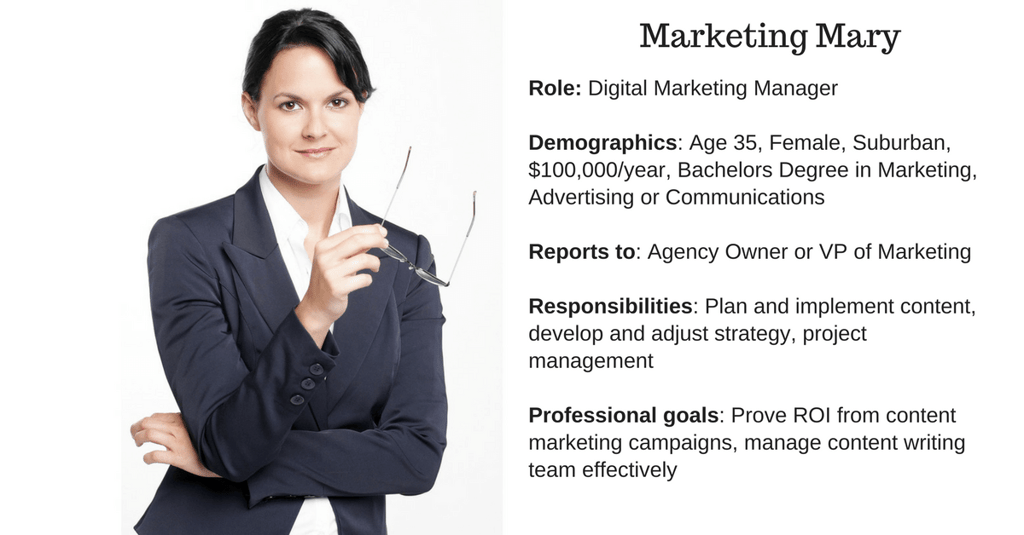Perhaps you’re in the process of creating buyer personas from scratch, or maybe you’ve devised buyer personas like the one below based on who you imagine your buyers are and they don’t seem to be working.

Or possibly, you’ve implemented personas and never looked back. No matter where your customer profiles stand, you need research-based buyer personas backed by real data in order to fulfill your inbound marketing goal of attracting more high-converting, loyal customers. Here are three ways to make sure your ideal customer profiles are serving your inbound marketing campaign.
1. Conduct Customer Surveys
If you really want to know what your customers think of you, why not ask them? Enter customer surveys. These types of questionnaires give you a direct glimpse into the minds of those who purchase products or services from your business.
While you could incorporate 100 questions into your survey thanks to online tools, like SurveyMonkey, it’s best not to – customers will be more willing to complete a survey with roughly 10 questions rather than one that takes a half hour to complete. Plus, more times than not, you may only have to ask a few key questions to begin building well-rounded buyer personas.
According to the Understanding B2B Buyers: The 2016 Benchmark Study conducted by Cintell, the top five attributes included in customer profiles by companies who exceed lead and revenue goals are as follows:
- Drivers and motivators (93.8%)
- Fears and challenges (87.5%)
- Role in buying process (87.5%)
- Organizational goals (75%)
- Demographic information (68.8%)
When devising questions for your customer survey, making sure to hit on the above-mentioned points will help shape each customer profile.
Consider this question: how did you learn about our product/service? This will give you insight into the stage at which the buyer found your website. Other questions you can ask may include:
- What industry do you work for?
- How many employees does your company employ?
- What’s your gender/age/annual income/level of education?
- Where do you live?
- How much time do you spend at work and home?
- Where do you prefer to do your shopping?
- What activities do you find stressful?
2. Interview Customers, Sales People and Your Executive Team
Another direct way to collect data from current customers, as well as your internal team, comes in the form of phone and in-person interviews. One-on-one conversations with those who know your brand can give you even greater insight into what your buyer personas should be. First, lay some ground rules and understand best practices for conducting interviews.
Rule number one: do not push your thoughts and ideas onto interviewees. You want to illicit genuine responses that will actually help you – even if their problems are not what you want to hear. In the same vein, stay away from leading questions. Again, you want to pull information from respondents, not lead them to an answer. Doing so will only result in bad data.
Rule number two: do not inquire about future behavior. Always ask about the past. If you weren’t already aware, history tends to repeat itself. Therefore, previous behaviors are generally good indicators of future behaviors. Sure, this isn’t always the case, but when it comes to creating ideal customer profiles, it’s best to stick to cold, hard data.
And the final rule: do not ask yes/no questions. You want interviewees to tell stories. As such, you should let them lead the conversation. Not only does this help build rapport, it can also reveal insights that you couldn’t predict or think to ask through questions alone.
Just like with surveys, you want to ask questions that uncover the interviewee’s motivators, fears and so on. Once you’ve garnered qualitative answers, you can then start to build buyer personas that target the unique goals, expectations, needs, challenges and concerns of each customer segment.
3. Review CRM/MA Data
There are limits to the amount of data you can obtain from surveys and interviews due to time constraints and low response rates. However, you most likely have an invaluable tool at your disposal that will let you test at scale – marketing automation (MA) and customer relationship management (CRM) software. When properly implemented, your CRM/MA data banks should contain buying behaviors of existing customers, which you can use to construct highly detailed, data-driven customer profiles.
To understand who your buyers are, dig deep into your CRM/MA data to uncover the following information:
- Each buyer’s role in the organization
- Their business wants and needs
- Why they did/didn’t purchase your product or service
- Who makes the final decision
- What landing pages or e-mails they clicked on
Keep in mind that this data is only a portion of the information that you can pull from your CRM/MA software to help paint a broader picture of your buyer personas. Once you’ve collected data from samples, you can then evaluate the information for insights and commonalities, as well as weed out outliers. Your next step? Segment customers into three to five buyer personas.
Using Customer Profiles is a Dynamic Process
While these are three proven methods for collecting real data to back your buyer personas, they’re definitely not the only options available to you. Besides interviews, surveys and CRM/MA data, you can also pull information from competitors’ websites, analytics data and external studies to help guide your inbound marketing strategy. And no matter where you pull data from, keep in mind that your personas should still reflect real life people with real motivations, desires, needs and concerns.
Crafting ideal customer profiles requires plenty of research, and even after personas are devised, you should continue to analyze, adjust and amend each profile on a fairly regular basis to accommodate new data.
If you already have a lot on your plate, this process may seem daunting. But, for an any inbound marketing campaign to work, developing truly useful buyer personas with good data is a must.
If it’s a lack of time or staff for content development or quality content writing that you’re facing, Virtucom Group’s monthly content subscription packages may be able to help – our expert writers and strategists will work to devise content that’s suited to your customer profiles and targeted to the different stages of the buyer’s journey.
About Virtucom Group
Consistent business blogging yields results – more clicks, more subscribers and – ultimately – more conversions. Whether you’re writing an automotive blog, an accounting blog, a healthcare blog or a home renovation blog, blogging for business and content development are useful for any industry. Follow the content writers at the Virtucom Group blog as they share digital marketing tips and discuss website content writing services that can optimize your business blog.






